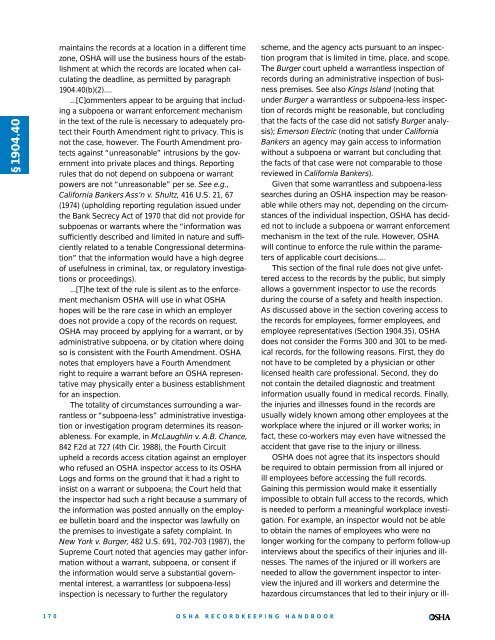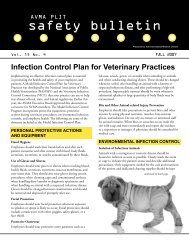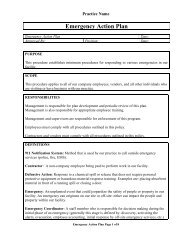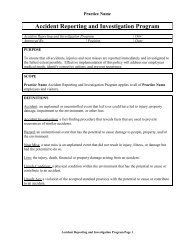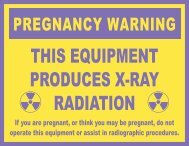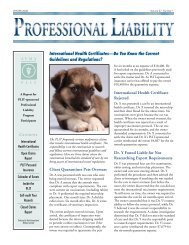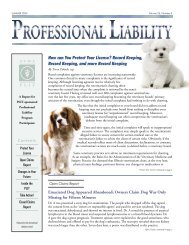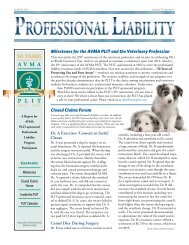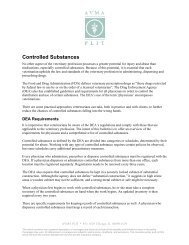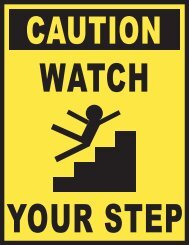OSHA Recordkeeping Handbook - denix
OSHA Recordkeeping Handbook - denix
OSHA Recordkeeping Handbook - denix
- No tags were found...
You also want an ePaper? Increase the reach of your titles
YUMPU automatically turns print PDFs into web optimized ePapers that Google loves.
§1904.40maintains the records at a location in a different timezone, <strong>OSHA</strong> will use the business hours of the establishmentat which the records are located when calculatingthe deadline, as permitted by paragraph1904.40(b)(2).......[C]ommenters appear to be arguing that includinga subpoena or warrant enforcement mechanismin the text of the rule is necessary to adequately protecttheir Fourth Amendment right to privacy. This isnot the case, however. The Fourth Amendment protectsagainst “unreasonable” intrusions by the governmentinto private places and things. Reportingrules that do not depend on subpoena or warrantpowers are not “unreasonable” per se. See e.g.,California Bankers Ass’n v. Shultz, 416 U.S. 21, 67(1974) (upholding reporting regulation issued underthe Bank Secrecy Act of 1970 that did not provide forsubpoenas or warrants where the “information wassufficiently described and limited in nature and sufficientlyrelated to a tenable Congressional determination”that the information would have a high degreeof usefulness in criminal, tax, or regulatory investigationsor proceedings)....[T]he text of the rule is silent as to the enforcementmechanism <strong>OSHA</strong> will use in what <strong>OSHA</strong>hopes will be the rare case in which an employerdoes not provide a copy of the records on request.<strong>OSHA</strong> may proceed by applying for a warrant, or byadministrative subpoena, or by citation where doingso is consistent with the Fourth Amendment. <strong>OSHA</strong>notes that employers have a Fourth Amendmentright to require a warrant before an <strong>OSHA</strong> representativemay physically enter a business establishmentfor an inspection.The totality of circumstances surrounding a warrantlessor “subpoena-less” administrative investigationor investigation program determines its reasonableness.For example, in McLaughlin v. A.B. Chance,842 F.2d at 727 (4th Cir. 1988), the Fourth Circuitupheld a records access citation against an employerwho refused an <strong>OSHA</strong> inspector access to its <strong>OSHA</strong>Logs and forms on the ground that it had a right toinsist on a warrant or subpoena; the Court held thatthe inspector had such a right because a summary ofthe information was posted annually on the employeebulletin board and the inspector was lawfully onthe premises to investigate a safety complaint. InNew York v. Burger, 482 U.S. 691, 702-703 (1987), theSupreme Court noted that agencies may gather informationwithout a warrant, subpoena, or consent ifthe information would serve a substantial governmentalinterest, a warrantless (or subpoena-less)inspection is necessary to further the regulatoryscheme, and the agency acts pursuant to an inspectionprogram that is limited in time, place, and scope.The Burger court upheld a warrantless inspection ofrecords during an administrative inspection of businesspremises. See also Kings Island (noting thatunder Burger a warrantless or subpoena-less inspectionof records might be reasonable, but concludingthat the facts of the case did not satisfy Burger analysis);Emerson Electric (noting that under CaliforniaBankers an agency may gain access to informationwithout a subpoena or warrant but concluding thatthe facts of that case were not comparable to thosereviewed in California Bankers).Given that some warrantless and subpoena-lesssearches during an <strong>OSHA</strong> inspection may be reasonablewhile others may not, depending on the circumstancesof the individual inspection, <strong>OSHA</strong> has decidednot to include a subpoena or warrant enforcementmechanism in the text of the rule. However, <strong>OSHA</strong>will continue to enforce the rule within the parametersof applicable court decisions....This section of the final rule does not give unfetteredaccess to the records by the public, but simplyallows a government inspector to use the recordsduring the course of a safety and health inspection.As discussed above in the section covering access tothe records for employees, former employees, andemployee representatives (Section 1904.35), <strong>OSHA</strong>does not consider the Forms 300 and 301 to be medicalrecords, for the following reasons. First, they donot have to be completed by a physician or otherlicensed health care professional. Second, they donot contain the detailed diagnostic and treatmentinformation usually found in medical records. Finally,the injuries and illnesses found in the records areusually widely known among other employees at theworkplace where the injured or ill worker works; infact, these co-workers may even have witnessed theaccident that gave rise to the injury or illness.<strong>OSHA</strong> does not agree that its inspectors shouldbe required to obtain permission from all injured orill employees before accessing the full records.Gaining this permission would make it essentiallyimpossible to obtain full access to the records, whichis needed to perform a meaningful workplace investigation.For example, an inspector would not be ableto obtain the names of employees who were nolonger working for the company to perform follow-upinterviews about the specifics of their injuries and illnesses.The names of the injured or ill workers areneeded to allow the government inspector to interviewthe injured and ill workers and determine thehazardous circumstances that led to their injury or ill-170<strong>OSHA</strong> RECORDKEEPINGHANDBOOK


